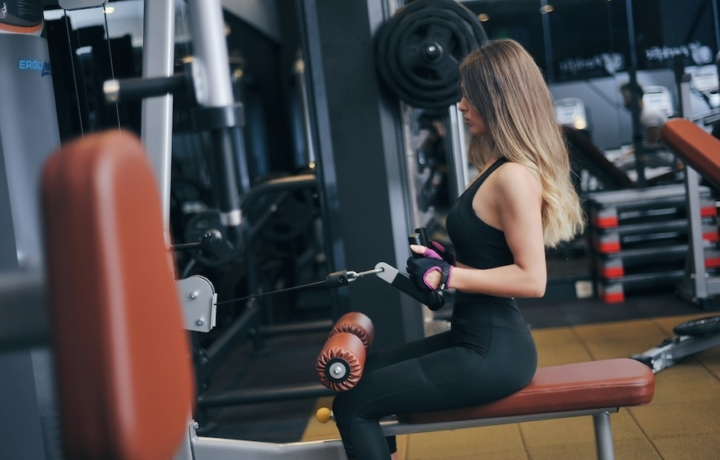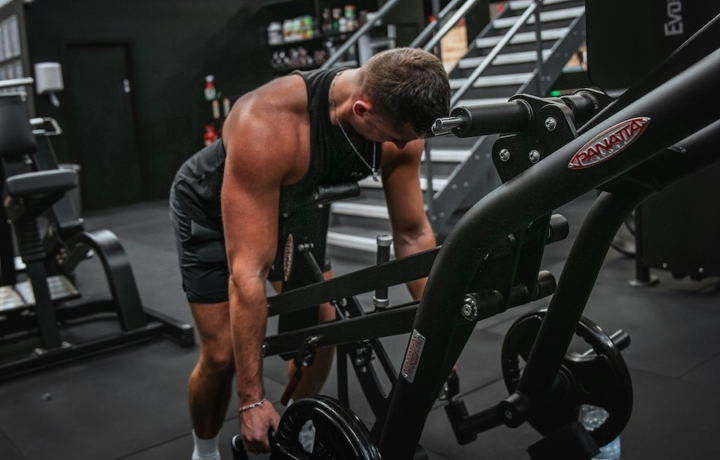Exercise
Cable Bar Lateral Pulldown

Cable Bar Lateral Pulldown
How to Perform
- Sit on the cable pulldown bench facing the machine, adjusting the seat height so your thighs fit comfortably under the knee pads.
- Grasp the bar with a wide overhand grip (hands wider than shoulder-width apart), keeping your wrists straight and palms facing forward.
- Start with your arms fully extended upward, creating a slight stretch in your lats while maintaining an upright torso with your chest up and shoulders back.
- Breathe in deeply and engage your core muscles to stabilize your spine.
- Pull the bar down toward your upper chest by driving your elbows down and slightly back, exhaling as you perform the pulling motion.
- Continue the downward motion until the bar reaches approximately chin level, keeping your torso upright without leaning back to assist the movement.
- Hold the contracted position briefly, focusing on squeezing your lats and keeping tension in your back muscles.
- Slowly return the bar to the starting position by extending your arms in a controlled manner while inhaling, maintaining tension throughout the movement.
Important information
- Avoid using momentum or swinging your torso backward to complete the movement, as this reduces effectiveness and increases injury risk.
- Keep your chest up and shoulders pulled back throughout the exercise to maintain proper form and target the correct muscles.
- Focus on pulling with your elbows rather than your hands to maximize lat engagement and minimize bicep dominance.
- If you experience shoulder discomfort, try adjusting your grip width or consulting with a fitness professional about your form.

Cable Bar Lateral Pulldown
Exercise Details
Primary Muscles
Muscle Groups
Mechanic
Risk Areas
Built for progress
Take the guesswork out of training
Create personalized AI-powered workout plans that evolve with you. Train smarter, track every rep and keep moving forward, one workout at a time.






The Cable Bar Lateral Pulldown stands as a stellar compound movement that powerfully engages the latissimus dorsi (lats) while simultaneously recruiting the side deltoids for stability and assistance. This intermediate-level exercise has earned its place in both bodybuilding and strength training regimens due to its effectiveness in developing a wider, more imposing back silhouette while enhancing upper body pulling strength.
What distinguishes the Cable Bar Lateral Pulldown from standard pulldowns is the emphasis on lateral engagement. The motion creates exceptional tension across the entire back, particularly targeting the outer lats that contribute to that coveted V-taper physique that bodybuilders prize. The side deltoids work as crucial synergists throughout the movement, receiving significant stimulation that promotes balanced shoulder development.
For strength enthusiasts, this exercise delivers impressive functional benefits. The unilateral nature of the movement helps identify and correct muscular imbalances between the left and right sides of the body. Additionally, the core stabilization required throughout the exercise translates to improved performance in other compound lifts like deadlifts and rows.
From a bodybuilding perspective, the Cable Bar Lateral Pulldown creates unique mechanical tension through its range of motion, stimulating muscle fibers that might not be fully activated during traditional pulldown variations. This makes it particularly valuable during hypertrophy-focused training phases when development of the outer lats becomes a priority.
Progressive overload principles apply beautifully to this exercise, allowing for systematic strength development as your neuromuscular efficiency improves. Many experienced lifters find they can handle surprisingly heavy loads with proper form, making this an excellent exercise for building both show and go – the aesthetic width bodybuilders seek alongside the functional strength that carries over to athletic performance.
When programmed strategically within a well-designed training split, the Cable Bar Lateral Pulldown delivers remarkable development to the upper back region while contributing to that balanced, powerful physique that represents the hallmark of intelligent resistance training.
FAQ - Cable Bar Lateral Pulldown
The Cable Bar Lateral Pulldown primarily targets the latissimus dorsi (lats) with significant engagement of the side deltoids as synergists. Your rhomboids, trapezius, and core muscles also work as stabilizers throughout the movement.
Unlike traditional pulldowns, the Cable Bar Lateral Pulldown emphasizes lateral engagement with a wider grip and more horizontal pulling angle. This creates exceptional tension across the outer lats that contribute to the V-taper physique, while also recruiting the side delts more intensively.
Incorporate this exercise 1-2 times weekly within your back or pull workouts, allowing 48-72 hours for recovery between sessions. As an intermediate movement, it works best when programmed alongside fundamental exercises like rows and traditional pulldowns.
The most common mistakes include rounding your lower back, rotating your hips instead of keeping them square, rushing through the movement, and not hinging properly at the hips. Focus on maintaining a neutral spine, moving with control, and keeping your standing knee slightly soft rather than locked.
For an easier version, place your feet wider apart on the ball or position the ball closer to your body. To increase difficulty, try performing the movement with one leg raised, holding a weight across your hips, or increasing time under tension by slowing down the movement.










